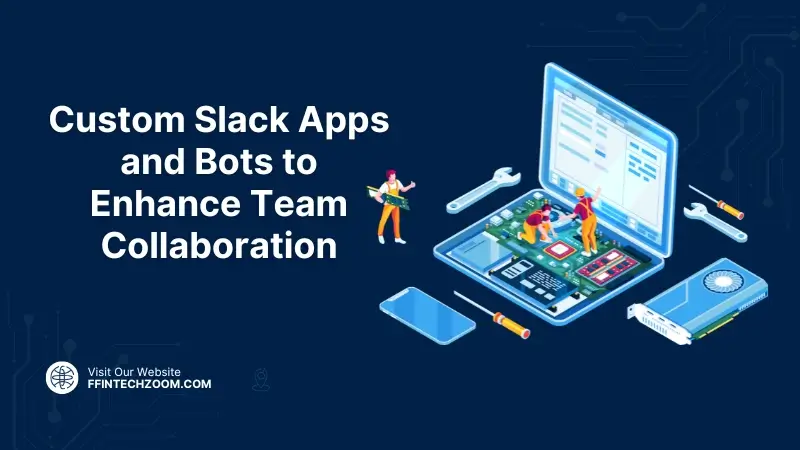Building Custom Slack Apps and Bots to Enhance Team Collaboration
As businesses continue to embrace digital transformation, streamlining workflows and enhancing communication is more critical than ever. Slack, a widely adopted collaboration platform, has become a cornerstone for many teams to stay connected, collaborate, and share information. The real power of Slack, however, lies in its extensibility, with Slack apps and bots offering an incredible opportunity to automate tasks, optimize team workflows, and improve productivity. With expertise from Fivewalls company, businesses can build custom Slack apps and bots that seamlessly integrate into their day-to-day operations.

Understanding Slack Apps and Bots
Slack apps and bots are tools that enhance the functionality of the Slack platform, automating tasks, integrating with external systems, and improving communication within teams. While Slack apps are broader tools or integrations that can include bots, workflows, and other features, Slack bots are specific automated programs designed to interact directly with users.
Key Capabilities of Slack Apps and Bots:
- Task Automation: Automate routine processes, such as meeting scheduling, daily updates, or project status tracking.
- Real-Time Notifications: Push alerts and notifications to team members about deadlines, project updates, or system statuses.
- Integration with External Tools: Slack apps can pull and push data from integrated systems like CRMs, project management tools, and analytics platforms.
- User Interaction: Slack bots can engage users by sending messages, collecting responses, and providing guidance, creating more efficient user workflows.
Read another trending article, Switching to VPS Hosting.
Getting Started with Slack App and Bot Development
Developing custom Slack apps and bots is a strategic approach to improve team collaboration. It requires careful planning and an understanding of the tools available for building and integrating bots and apps within Slack.
Prerequisites:
- Technical Skills: Familiarity with programming languages such as JavaScript, Python, or Node.js is essential.
- Slack API Knowledge: Understanding Slack’s API and how to interact with it to access Slack’s core features.
Development Tools:
- Slack API: The primary tool to interact with Slack services, enabling developers to create custom integrations and automate processes.
- Block Kit: Slack’s UI framework for creating interactive and visually appealing messages within Slack.
- Workflow Builder: A no-code tool within Slack for creating simple, automated workflows that do not require coding expertise.
Check out our comprehensive article on Smart Businesses Doing Right About Careers and Culture for additional information.
Step-by-Step Guide to Building a Simple Slack Bot:
- Define the Purpose: Determine the specific tasks the bot will automate to ensure it aligns with your team’s needs.
- Create a Slack App: Register your bot as a Slack app through the Slack API portal. This is the foundation for your custom bot.
- Develop the Bot: Write the code to handle user interactions, automate processes, and integrate with other services. Utilize the Slack API and SDKs for custom functionality.
- Testing: Test the bot in a controlled Slack environment to ensure it functions as intended.
- Deploy and Integrate: Deploy the bot into your workspace and ensure it integrates seamlessly with your existing workflows.
Advanced Features of Slack Apps and Bots
As businesses grow, so do their needs for more advanced functionality. Custom Slack apps and bots can be developed to integrate deeper with other business systems and provide more sophisticated automation.
Integration with External APIs
Slack bots and apps can interact with a wide range of external services and platforms. Some examples include:
- CRM Systems: Sync Slack with customer relationship management systems like Salesforce to automate updates and share relevant customer data.
- Project Management Tools: Integrate with project management platforms like Asana, Jira, or Trello to create, track, and update tasks directly from within Slack.
Find valuable tips and strategies in our article about Skip Bins Simplify And Manage Waste.
Natural Language Processing (NLP)
By integrating NLP, Slack bots can understand and respond to more natural and complex user inputs, making them more intuitive and easier for team members to interact with.
AI and Machine Learning
Advanced Slack bots can leverage machine learning to predict workflows, provide recommendations, and even automate decision-making processes, improving overall team productivity.
Case Study: Developing a Custom Slack Bot for GlobalTech Solutions
GlobalTech Solutions, a leading IT consulting firm, faced challenges with managing internal communications and tracking project progress. Their employees were constantly switching between Slack, email, and project management tools, causing inefficiencies. GlobalTech partnered with Fivewalls to develop a custom Slack bot that would integrate their internal systems and streamline workflows.
Challenges:
- Multiple Communication Tools: Team members were overwhelmed with managing messages across different platforms.
- Manual Task Updates: Employees had to manually track project statuses and deadlines, leading to missed information.
Slack Bot Solutions Implemented:
- Task Tracking: The custom bot was designed to automatically track and update project tasks in Slack, integrating with GlobalTech’s existing project management tool, Trello.
- Team Communication: The bot facilitated quick communication by sending reminders, managing internal discussions, and automatically archiving messages for easy retrieval.
Technologies Used:
- Node.js
- Slack API
- MongoDB
Outcomes:
- Enhanced Efficiency: Automated task updates and notifications led to fewer missed deadlines and more streamlined workflows.
- Reduced Tool Switching: Team members no longer needed to switch between multiple apps for task management or communication.
- Positive Feedback: The custom Slack bot received praise for simplifying processes and enhancing productivity.
This example highlights how a custom Slack bot can solve specific challenges faced by businesses, creating a more integrated and efficient workflow.
Best Practices for Developing Slack Apps and Bots
To maximize the impact of your custom Slack bot or app, it’s essential to follow best practices during the development process.
User-Centric Design:
- Clear and Intuitive Interactions: Ensure the bot communicates in a clear, user-friendly manner, with easy-to-understand prompts and responses.
- Seamless Integration: The bot should seamlessly fit into your team’s existing workflows, minimizing disruptions and maximizing value.
Security Considerations:
- Data Privacy: Implement encryption and access controls to protect sensitive data shared by users.
- Permission Management: Ensure that only authorized users can access or modify critical information through the bot.
Maintenance and Updates:
- Regular Monitoring: Track the bot’s performance and resolve any issues promptly to ensure it functions smoothly.
- User Feedback: Continuously gather feedback from users to improve the bot’s functionality and user experience over time.
Conclusion
Custom Slack apps and bots have the potential to revolutionize how teams collaborate, communicate, and automate tasks. By creating tailored solutions that integrate with existing tools and workflows, businesses can significantly improve efficiency and productivity. The ability to automate routine tasks, send real-time notifications, and connect to external systems is a game-changer for organizations looking to stay ahead of the competition.
Developing and integrating Slack bots into your team’s workflow not only helps reduce manual work but also positions your business to handle the complexities of modern work environments. As the business landscape continues to evolve, embracing these tools ensures that teams remain agile, efficient, and ready for the challenges of tomorrow. You can visit Fintechzoom.com for more trending posts.




